To tylko jedna z 4 stron tej notatki. Zaloguj się aby zobaczyć ten dokument.
Zobacz
całą notatkę



WCoB Competition Documentation – Scandinavian
Figure 1 – Basis for Project - 14th century voided work wall hanging, Iceland
Background
I have chosen the above wall hanging worked in laid and couched work as the inspiration for
this project. It was made in the 14th Century in Iceland, and originally resided in a church in
Hvau, Northern Iceland. It now resides in the National Museum in Denmark.
The panel shown is 60cm high and approximately 180cm wide. Both the top and bottom of the
wall hanging have suffered damage over time.
It is made of a black woollen ground fabric with the pattern worked in laid and couched work,
the pattern worked in reverse, that is, the design has been left void and the background has the
stitching. The outline couching is done in a thicker thread than the rest of the piece.
There are many surviving examples of
early Scandinavian embroidery,
including 11 (of 18) from Iceland
worked using the laid and couched
technique1. The predominant form of
stitching is laid and couched work,
referred to as resfilmur in Iceland.
This stitch is created by laying a set of
ground threads, that work from one side
of the pattern to the other. Over these
threads, in the opposite direction, are
laid another set of threads at regular
intervals. These cross threads are then
held down by a series of couching
stitches. The whole process results in
Figure 2 – Process of Laid and Couched Work or resfilmur
an area completely covered in thread
(see Figure 2 for an illustration of how
this stitch is worked).
1
The remaining 7 extant items (mostly altar frontals) are worked in a variety of techniques including pattern
darning, stem stitch, appliqué and split stitch.
Jane Stockton – Barony of Mordenvale, Kingdom of Lochac – jane_stockton@webcon.net.au
1
The predominant materials used in Icelandic
embroidery of the time were wool thread on
wool or linen ground fabrics. Wool
materials (both thread and ground fabric)
tended to be of domestic manufacture while
linen was usually imported. Very little use is
made of silk thread, even in items for
ecclesiastical use. Wool thread was used
most extensively, even when working
stitches such as cross stitch and straight
darning (glitsaumur).
Figure 3 – This 16th Century altar frontal from
Draflastadir Church in northern Iceland shows
resfilmur used to cover the entire linen ground in
wool thread.
Another characteristic of Icelandic
embroidery, especially resfilmur is the
practice of completely covering the ground
fabric with stitching. In the most famous laid
and couched embroidery, the Bayeux
Tapestry, on the figures and other design
elements are worked, the the linen ground
being left plain.
Pattern
Rather than recreate the entire piece (which due to
its size would have taken too long and not been of
practical use), I chose to use one roundel2 as the
basis for my design, which would then become a
cushion3. Because I was using only one roundel, I
had to adapt the pattern. I dropped the inter-linking
ring
(…)
… History: In Memory of Harold B. Burnham, pp. 133-143.
Toronto: Royal Ontario Museum, 1977
Gudjonsson, Elsa. “Islandske Broderier og Broderersker I Middelalderen” in Förändringar I
kvinnors villkor under medeltiden Uppstser framlagda vid ett kvinnohistoriskt symposium I
Skálholt, Island, 22.-25. Juni 1981 (Reykjavík: Rit Sagnfrædistofnuar 9, 1983)
Østergård, Else. “Textilfragmenterne fra Mammengraven“ in…
….
7
There is a type of cushion called agedynor or travel cushion that uses an envelope slip to cover the insert. This
information was provided via email by Her Excellency Marienna Jensdatter, Baroness Ildhafn.
Jane Stockton – Barony of Mordenvale, Kingdom of Lochac – jane_stockton@webcon.net.au
3
Bibliography
Bridgeman, Harriet; and Drury, Elizabeth. (eds). – “Needlework, an Illustrated History…
... zobacz całą notatkę






Komentarze użytkowników (0)